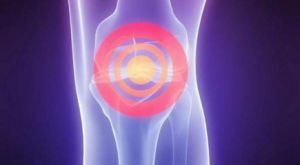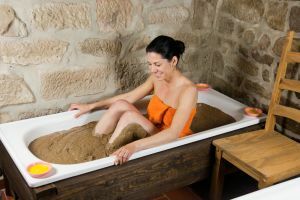 Dupuytren's contracture is one of the complex diseases that causes serious complications, and progresses to contracture of the tendons of the fingers of the hand.
Dupuytren's contracture is one of the complex diseases that causes serious complications, and progresses to contracture of the tendons of the fingers of the hand.
Despite the breakthrough of modern medicine, the disease still does not give up leading positions, turning absolutely healthy people into helpless invalids. And the first symptoms were recorded in the middle of the XIX century.
A. Kupper argued that the mobility of the fingers depends on the contraction of the muscles located on the surface of the palm.
But the detailed clinical characteristics of the French surgeon G. Dupuytren in the thirties of the XIX century, he conducted clinical studies on which all the achievements of modern medicine are based.
Now the disease bears his name Dupuytren's Disease.
Contents of the article
- General concept of the disease
- Age of the disease
- Risk factors
- Symptoms of the disease at different stages of development
- Diagnosis of
- Methods of conservative therapy
- Surgical procedure
- Aponevrectectomy
- Postoperative surgery
- What is included in the rehabilitation?
General concept of the disease
According to the international medical classification of diseases since 1974 Dupuytren's contracture refers to the fibromatous group.
For the disease is characterized by limited work of the joints of the hand.
The limb loses its elasticity, and the arm does not completely bend or contract in the joints.
This is because scar tissue forms on the skin, they tighten the skin that covers the tendons. The joints will be inflamed. There are painful sensations.
There are 2 types of pathology:
- passive( structural);
- is active( neurogenic).
Usually, disease formation can be observed during the operation of an anonymous finger or little finger. But the disease can spread to all fingers, gradually shifting to the other hand.
Age of the disease
According to statistics, young people rarely face this problem, but recently palmar fibromatosis "began to grow young."
Especially among men who show signs of illness more often than women. Often the symptoms are manifested in middle-aged people. If the disease manifested itself in young years, it quickly progresses and proceeds in severe form.
At first, the symptoms are insignificant, people do not pay attention to them, small buds appear at the base of the fingers, which do not cause pain.
If you do not pay attention to symptoms in time, the disease will quickly turn into a severe form. Usually between the first symptoms there is a long period of time( months and years).
Risk Factors
There are many theories, each of which can explain the causes of the disease:
- as a result of the injury;
- disrupted endocrine system;
- is neurogenic, rarely found( 1-3% of cases);
- heredity;
- harmful habits of nicotine and alcohol dependence, are independent risk factors for the development of this disease;
- is often found in people with diabetes and people prone to epileptic seizures.
According to this theory, Dupuytren's contracture is a disease that affects the connective tissue system, rather than an isolated frankincanal aport. Often occurs as a result of injuries of the musculoskeletal system.
Symptoms of the disease at different stages of development of
Depending on the stage, such pathological symptoms are distinguished:
- subcutaneous seals appear, which do not cause discomfort when compressing the fingers. At the first stage, the patient does not yet need surgical intervention.
- The patient feels the discomfort in the hand when flexing the fingers of the , during this period it is still possible to limit the clinical treatment that helps restore the compression of the fingers.
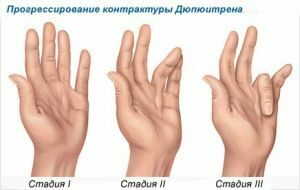
- Deficiency of extension of fingers, the deformation process covers the surface of the palm of the hand .Surgery may cause complications. Apply radical methods of treatment for straightening of fingers. The operation may cause problems. The skin loses its elasticity. The vascular nerve endings of the fingers are severely strained. Therefore, operations do not always lead to a positive result.
- Pathology is amplified by .At this stage, the disease penetrates the tendon apparatus and joints. Surgical intervention is ineffective.
Diagnosis of
The diagnosis is made by an orthopedist - traumatologist. After hearing the complaints, and will conduct a survey of the patient.
It is necessary to determine the stage of the development of the disease, which area is already affected and how much the contracture affects the performance of the brush.
The doctor should ask the patient about his lifestyle of bad habits. It is necessary to determine whether the disease is hereditary.
The doctor then examines the brush, as it is necessary to study the mobility of the fingers. During the consultation, the doctor can determine the thickness of the palmar fascia, which manifests itself in the form of nodules cones( the closer the formation, the more time will require treatment.)
At first, the nodules appear on the palm, gradually shifting to the fingers.
Conservative Therapy Methods
Usually, two clinical and operative methods are used to treat Dupuytren's contracture. When choosing a method of treatment, it is necessary to take into account the nature and symptoms of the disease. The technique was developed by leading traumatologists, orthopedists and surgeons.
Conservative method is used in the initial stages of the disease:
- massage;
- therapeutic gymnastics, it helps to develop a hand;
- physiotherapy;
- corrective procedures( tire, or plaster bandage), it is necessary to fix the fingers in the extended position. Usually a lingual bandage is applied before bed, the arm should be at rest;
- warm baths;
- compresses;
- lotion;
- injection, usually prescribed steroid drugs.
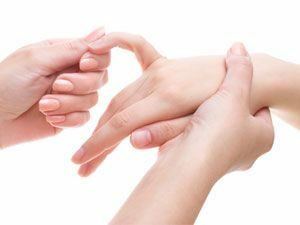 With the help of clinical therapy, it is possible for some time to contain the spread of the disease and slow the formation of tight cones on the arm.
With the help of clinical therapy, it is possible for some time to contain the spread of the disease and slow the formation of tight cones on the arm.
The fingers become movable. But this is only a temporary measure, with time it is necessary to resort to surgical intervention.
According to statistics, patients who are under the constant supervision of a specialist and follow all the prescriptions easily tolerate the operation. And the rehabilitation period comes less painful.
In rare cases, after the operation, there are side effects. In young people, sometimes after the operation, new formations on the palm may appear, in which case a repeated surgical intervention will be required.
Usually, the disease "returns" after a few years or decades.
Surgical intervention
The main goal is to remove the affected area. The palmar fascia is partially( completely) subjected to excision. After the operation, you can observe the positive dynamics, restore the mobility of the fingers in the brush in full.
Aponevrectectomy
This is a complex operation that is performed to remove contracture. This is a radical method of treatment, the technique of which is rather complicated. The operation is performed by surgeons of the highest category. 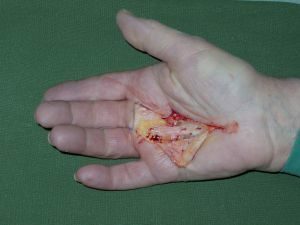
All complications that may occur during the operation must be considered. Accuracy of actions will allow to define a problem and to find the optimum decision in a critical situation.
Principle of aponevrectectomy: remove the affected tissue, while not damaging the nerve endings of the hand, and the system of blood supply to the fingers of the hand.
Post-operation surgery
To give the skin its original appearance, it is necessary to remove all the defects that appear during the operation:
- to avoid pathologies and not to disturb the blood supply to the skin;
- it is necessary to prevent the appearance of bruising;
- effectively closes wounds.
It is necessary to choose an anesthetic drug that is used for the operation( local or general anesthesia).
Then treat the palm, which is usually done using enzyme preparations. It is necessary that during the operation it is possible to easily separate the scar tissue that is located under the skin.
If properly prepared for the operation, the skin areas are not subjected to severe excision.
But successful operation does not guarantee full recovery, a full complex of procedures is needed.
To achieve a positive result, it is necessary to conduct:
- preoperative preparation;
- operation;
- and recovery period after surgery.
What is included in the rehabilitation?
After the operation, the patient needs to undergo a set of restorative procedures:
- massage;
- visit the physical.cabinet;
- electrophoresis.
This is necessary to restore the motor function. Rehabilitation should ensure a full quality of life.

